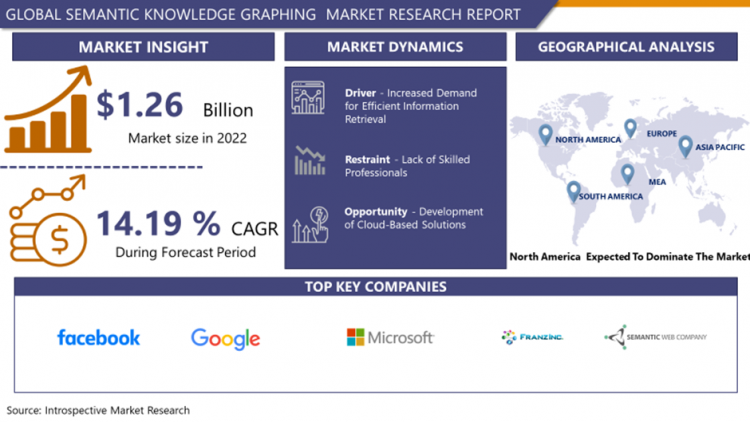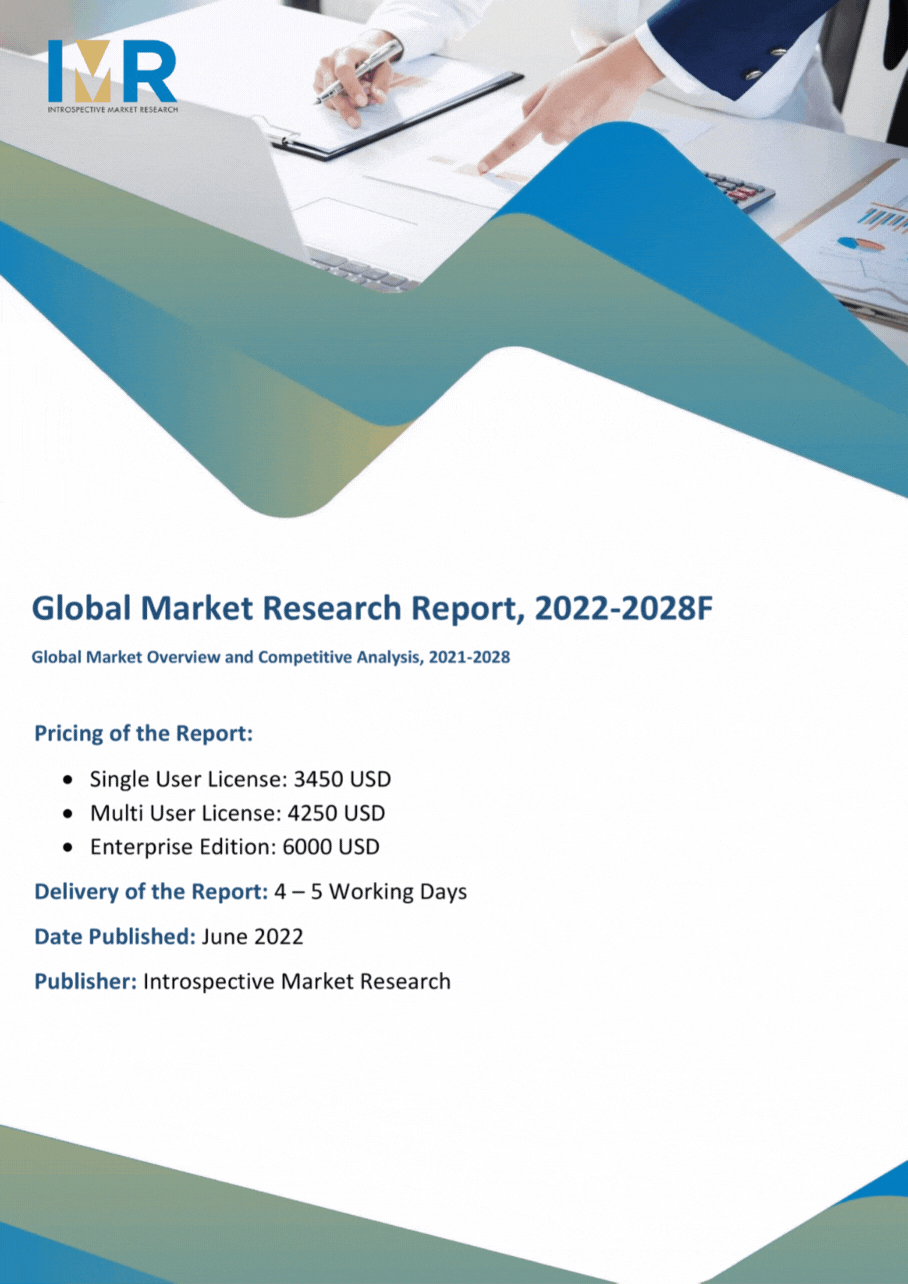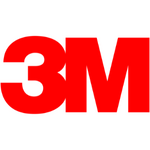Semantic Knowledge Graphing Market Synopsis
Semantic Knowledge Graphing Market Size Was Valued at USD 1.26 Billion in 2022, and is Projected to Reach USD 3.64 Billion by 2030, Growing at a CAGR of 14.19 % From 2023-2030.
Semantic Knowledge Graphing entails the organization and linkage of data to unveil significant connections among entities. It arranges information into a graph structure, with nodes representing concepts or entities, and edges indicating relationships. This methodology enables streamlined data retrieval, analysis, and inference, empowering diverse applications like search engines, recommendation systems, and natural language processing.
- The Semantic Knowledge Graphing involves organizing data into a graph structure where entities, relationships, and attributes are interconnected, facilitating advanced data analysis. Its applications span various domains, including natural language processing, recommendation systems, and data integration. In healthcare, it aids in diagnosing patients by correlating symptoms with medical conditions. E-commerce platforms use it to provide personalized product recommendations based on user preferences and purchase history.
- Semantic Knowledge Graphing is numerous. It improves data comprehension and enables semantic search, resulting in more accurate information retrieval. Additionally, it promotes interoperability among disparate data sources, leading to improved data integration and decision-making. Furthermore, it enables automated reasoning and inference, allowing systems to derive new insights from existing knowledge.
- Semantic Knowledge Graphing includes the adoption of machine learning techniques for graph embeddings, which enhance the representation of entities and relationships within the graph. Moreover, there is a growing emphasis on augmenting knowledge graphs through the inclusion of external knowledge sources like ontologies and linked data. Additionally, there is increasing interest in federated knowledge graphs, which enable organizations to collaborate and share knowledge while maintaining data sovereignty.

Semantic Knowledge Graphing Market Trend Analysis
Increased Demand for Efficient Information Retrieval
- The rising demand for effective information retrieval is driving the growth of the Semantic Knowledge Graphing market. data-driven world, businesses grapple with managing vast amounts of data spread across various sources. Traditional methods of retrieving information often prove inadequate in navigating this complexity, resulting in inefficiencies and missed opportunities. there is a growing acknowledgment of the necessity for advanced solutions to streamline data access and uncover valuable insights quickly and accurately.
- Semantic Knowledge Graphing addresses this need by providing a structured approach to organizing and linking data, thereby enabling more efficient information retrieval. By organizing data into a graph format with clearly defined entities and relationships, this technology facilitates intuitive navigation and exploration of complex datasets. Moreover, the semantic understanding embedded within the graph enables contextualized search capabilities, enhancing the relevance and precision of search results. As businesses increasingly rely on data-driven decision-making and seek competitive advantages through insights, the demand for Semantic Knowledge Graphing solutions continues to rise.
- Furthermore, the proliferation of diverse data sources and the complexity of modern datasets highlight the importance of Semantic Knowledge Graphing in meeting the evolving needs of businesses. With the integration of machine learning techniques and the inclusion of external knowledge sources like ontologies and linked data, Semantic Knowledge Graphing solutions are becoming more proficient at extracting meaningful insights from diverse and dynamic data environments.
Development of Cloud-Based Solutions
- The emergence of cloud-based solutions offers significant opportunities for the expansion of the Semantic Knowledge Graphing market. Cloud computing provides a scalable and adaptable infrastructure for hosting and processing large datasets, making it an optimal environment for deploying Semantic Knowledge Graphing solutions. By utilizing cloud-based platforms, businesses can access the necessary computational resources for implementing and managing complex knowledge graphs without the overhead of maintaining on-premises infrastructure.
- Cloud-based solutions facilitate seamless collaboration and integration among dispersed teams and data sources. This promotes the sharing and enhancement of knowledge graphs, resulting in more comprehensive and precise data representations. Furthermore, cloud platforms often come equipped with built-in support for data analytics and machine learning, empowering organizations to derive deeper insights and foster innovation through Semantic Knowledge Graphing implementations.
- The scalability and cost-effectiveness of cloud-based solutions render them accessible to businesses of all sizes, from startups to large enterprises. This democratization of technology reduces barriers to entry and encourages widespread adoption of Semantic Knowledge Graphing, thereby driving market growth. As the demand for efficient data management and advanced analytics continues to increase, the development of cloud-based solutions will remain crucial for unlocking the full potential of Semantic Knowledge Graphing across various industries.
Semantic Knowledge Graphing Market Segment Analysis:
Semantic Knowledge Graphing Market Segmented on the basis of Graph Type, Task Type, Source, Organization Size, Application, and Industry Vertical
By Task Type, Link prediction segment is expected to dominate the market during the forecast period
- The Link Prediction segment is positioned to lead the Semantic Knowledge Graphing market, given its critical function in revealing latent relationships and improving data comprehension. In today's interconnected landscape, identifying absent connections between entities is crucial for deriving holistic insights from knowledge graphs. Link prediction algorithms assess existing links within the graph to anticipate potential relationships, bridging gaps in the data and enriching the knowledge representation. This capability holds significant value across various sectors, including recommendation systems, social network analysis, and biomedical research, where uncovering concealed associations can drive actionable insights and enhance decision-making.
- Moreover, with businesses increasingly embracing data-driven approaches to stay competitive, the demand for sophisticated link prediction techniques is expected to rise. By harnessing machine learning and graph analytics, link prediction solutions offer scalable and effective means for identifying and prioritizing missing links, fueling the expansion of the Semantic Knowledge Graphing market.
By Organization Size, Large Organizations segment held the largest share of 74.4% in 2022
- The Semantic Knowledge Graphing market is predominantly led by large enterprises, owing to their expansive data ecosystems and intricate information management requirements. These organizations grapple with the substantial task of organizing, integrating, and extracting insights from vast volumes of data generated across diverse departments and systems. Semantic Knowledge Graphing emerges as a solution by offering a structured framework to connect and analyze disparate data sources, empowering these enterprises to obtain a comprehensive understanding of their data landscape.
- Furthermore, large enterprises possess the resources and capabilities to invest in advanced technologies such as Semantic Knowledge Graphing. They can allocate budgets for the implementation and upkeep of sophisticated data management solutions, thereby driving adoption in this segment. Additionally, the scalability and customizable features of Semantic Knowledge Graphing align with the varied needs and complexities encountered by large enterprises, making it the preferred option for addressing their information management challenges.
Semantic Knowledge Graphing Market Regional Insights:
North America is Expected to Dominate the Market Over the Forecast period
- North America is positioned to lead the Semantic Knowledge Graphing market due to several key factors. The region boasts a thriving ecosystem of technology firms, research institutions, and startups specializing in data science and artificial intelligence. With Silicon Valley as a global innovation hub, North American companies lead in developing state-of-the-art Semantic Knowledge Graphing solutions.
- North America demonstrates significant adoption of advanced technologies across various sectors like healthcare, finance, and e-commerce. Its mature infrastructure, coupled with a strong focus on digital transformation, fosters an environment conducive to Semantic Knowledge Graphing solution implementation. Moreover, the presence of large enterprises with extensive datasets drives demand for sophisticated data management and analytics tools, propelling the growth of the Semantic Knowledge Graphing market in the region.
Semantic Knowledge Graphing Market Top Key Players:
- Amazon.com Inc. (U.S.)
- Facebook Inc (U.S.)
- Google LLC (U.S.)
- Franz Inc. (U.S.)
- Stardog Union (U.S.)
- Microsoft Corporation (U.S.)
- Metaphacts GmbH (Germany)
- NELL (Norway)
- Semantic Web Company (Austria)
- Yandex (Russia)
- Ontotext (Bulgaria)
- YAGO (Taiwan)
- Mitsubishi Electric Corporation (Japan)
- Baidu, Inc. (China), and Other Major Players
Key Industry Developments in the Semantic Knowledge Graphing Market:
In January 2023, Digital Science completed the acquisition of metaphacts a knowledge graph and decision intelligence software company. which has become the newest member of the Digital Science family.
|
Global Semantic Knowledge Graphing Market |
|||
|
Base Year: |
2022 |
Forecast Period: |
2023-2030 |
|
Historical Data: |
2017 to 2022 |
Market Size in 2022: |
USD 1.26 Bn. |
|
Forecast Period 2023-30 CAGR: |
14.19 % |
Market Size in 2030: |
USD 3.64 Bn. |
|
Segments Covered: |
By Graph Type |
|
|
|
By Task Type |
|
||
|
By Source |
|
||
|
By Organization Size |
|
||
|
By Application |
|
||
|
By Industry Vertical |
|
||
|
By Region |
|
||
|
Key Market Drivers: |
|
||
|
Key Market Restraints: |
|
||
|
Key Opportunities: |
|
||
|
Companies Covered in the report: |
|
||
- INTRODUCTION
- RESEARCH OBJECTIVES
- RESEARCH METHODOLOGY
- RESEARCH PROCESS
- SCOPE AND COVERAGE
- Market Definition
- Key Questions Answered
- MARKET SEGMENTATION
- EXECUTIVE SUMMARY
- MARKET OVERVIEW
- GROWTH OPPORTUNITIES BY SEGMENT
- MARKET LANDSCAPE
- PORTER’S FIVE FORCES ANALYSIS
- Bargaining Power Of Supplier
- Threat Of New Entrants
- Threat Of Substitutes
- Competitive Rivalry
- Bargaining Power Among Buyers
- INDUSTRY VALUE CHAIN ANALYSIS
- MARKET DYNAMICS
- Drivers
- Restraints
- Opportunities
- Challenges
- MARKET TREND ANALYSIS
- REGULATORY LANDSCAPE
- PESTLE ANALYSIS
- PRICE TREND ANALYSIS
- PATENT ANALYSIS
- TECHNOLOGY EVALUATION
- MARKET IMPACT OF THE RUSSIA-UKRAINE WAR
- Geopolitical Market Disruptions
- Supply Chain Disruptions
- Instability in Emerging Markets
- ECOSYSTEM
- PORTER’S FIVE FORCES ANALYSIS
- SEMANTIC KNOWLEDGE GRAPHING MARKET BY GRAPH TYPE (2017-2030)
- SEMANTIC KNOWLEDGE GRAPHING MARKET SNAPSHOT AND GROWTH ENGINE
- MARKET OVERVIEW
- EXTERNAL-SENSING KNOWLEDGE GRAPHS
- Introduction And Market Overview
- Historic And Forecasted Market Size in Value (2017 – 2030F)
- Historic And Forecasted Market Size in Volume (2017 – 2030F)
- Key Market Trends, Growth Factors And Opportunities
- Geographic Segmentation Analysis
- CONTEXT-RICH KNOWLEDGE GRAPHS
- NLP KNOWLEDGE GRAPHS
- SEMANTIC KNOWLEDGE GRAPHING MARKET BY TASK TYPE (2017-2030)
- SEMANTIC KNOWLEDGE GRAPHING MARKET SNAPSHOT AND GROWTH ENGINE
- MARKET OVERVIEW
- LINK PREDICTION
- Introduction And Market Overview
- Historic And Forecasted Market Size in Value (2017 – 2030F)
- Historic And Forecasted Market Size in Volume (2017 – 2030F)
- Key Market Trends, Growth Factors And Opportunities
- Geographic Segmentation Analysis
- ENTITY RESOLUTION
- LINK-BASED CLUSTERING
- SEMANTIC KNOWLEDGE GRAPHING MARKET BY SOURCE (2017-2030)
- SEMANTIC KNOWLEDGE GRAPHING MARKET SNAPSHOT AND GROWTH ENGINE
- MARKET OVERVIEW
- STRUCTURED
- Introduction And Market Overview
- Historic And Forecasted Market Size in Value (2017 – 2030F)
- Historic And Forecasted Market Size in Volume (2017 – 2030F)
- Key Market Trends, Growth Factors And Opportunities
- Geographic Segmentation Analysis
- UNSTRUCTURED
- SEMI-STRUCTURED
- SEMANTIC KNOWLEDGE GRAPHING MARKET BY ORGANIZATION SIZE (2017-2030)
- SEMANTIC KNOWLEDGE GRAPHING MARKET SNAPSHOT AND GROWTH ENGINE
- MARKET OVERVIEW
- SMES.
- Introduction And Market Overview
- Historic And Forecasted Market Size in Value (2017 – 2030F)
- Historic And Forecasted Market Size in Volume (2017 – 2030F)
- Key Market Trends, Growth Factors And Opportunities
- Geographic Segmentation Analysis
- LARGE ORGANIZATIONS
- SEMANTIC KNOWLEDGE GRAPHING MARKET BY APPLICATION (2017-2030)
- SEMANTIC KNOWLEDGE GRAPHING MARKET SNAPSHOT AND GROWTH ENGINE
- MARKET OVERVIEW
- SEMANTIC SEARCH
- Introduction And Market Overview
- Historic And Forecasted Market Size in Value (2017 – 2030F)
- Historic And Forecasted Market Size in Volume (2017 – 2030F)
- Key Market Trends, Growth Factors And Opportunities
- Geographic Segmentation Analysis
- QNA MACHINES
- ELECTRONIC READING
- INFORMATION RETRIEVAL
- SEMANTIC KNOWLEDGE GRAPHING MARKET BY INDUSTRY VERTICAL (2017-2030)
- SEMANTIC KNOWLEDGE GRAPHING MARKET SNAPSHOT AND GROWTH ENGINE
- MARKET OVERVIEW
- BFSI
- Introduction And Market Overview
- Historic And Forecasted Market Size in Value (2017 – 2030F)
- Historic And Forecasted Market Size in Volume (2017 – 2030F)
- Key Market Trends, Growth Factors And Opportunities
- Geographic Segmentation Analysis
- HEALTHCARE
- IT & TELECOM
- RETAIL & E-COMMERCE
- GOVERNMENT
- COMPANY PROFILES AND COMPETITIVE ANALYSIS
- COMPETITIVE LANDSCAPE
- Competitive Positioning
- Semantic Knowledge Graphing Market Share By Manufacturer (2022)
- Industry BCG Matrix
- Heat Map Analysis
- Mergers & Acquisitions
- FACEBOOK INC. (U.S.)
- Company Overview
- Key Executives
- Company Snapshot
- Role of the Company in the Market
- Sustainability and Social Responsibility
- Operating Business Segments
- Product Portfolio
- Business Performance (Production Volume, Sales Volume, Sales Margin, Production Capacity, Capacity Utilization Rate)
- Key Strategic Moves And Recent Developments
- SWOT Analysis
- FACEBOOK INC (U.S.)
- GOOGLE LLC (U.S.)
- FRANZ INC. (U.S.)
- STARDOG UNION (U.S.)
- MICROSOFT CORPORATION (U.S.)
- METAPHACTS GMBH (GERMANY)
- NELL (NORWAY)
- SEMANTIC WEB COMPANY (AUSTRIA)
- YANDEX (RUSSIA)
- ONTOTEXT (BULGARIA)
- YAGO (TAIWAN)
- MITSUBISHI ELECTRIC CORPORATION (JAPAN)
- BAIDU, INC. (CHINA)
- COMPETITIVE LANDSCAPE
- GLOBAL SEMANTIC KNOWLEDGE GRAPHING MARKET BY REGION
- OVERVIEW
- NORTH AMERICA
- Key Market Trends, Growth Factors And Opportunities
- Key Manufacturers
- Historic And Forecasted Market Size By Graph Type
- Historic And Forecasted Market Size By Task Type
- Historic And Forecasted Market Size By Source
- Historic And Forecasted Market Size By Organization Size
- Historic And Forecasted Market Size By Application
- Historic And Forecasted Market Size By Industry Vertical
- Historic And Forecasted Market Size By Country
- USA
- Canada
- Mexico
- EASTERN EUROPE
- Key Market Trends, Growth Factors And Opportunities
- Key Manufacturers
- Historic And Forecasted Market Size By Segments
- Historic And Forecasted Market Size By Country
- Russia
- Bulgaria
- The Czech Republic
- Hungary
- Poland
- Romania
- Rest Of Eastern Europe
- WESTERN EUROPE
- Key Market Trends, Growth Factors And Opportunities
- Key Manufacturers
- Historic And Forecasted Market Size By Segments
- Historic And Forecasted Market Size By Country
- Germany
- United Kingdom
- France
- The Netherlands
- Italy
- Spain
- Rest Of Western Europe
- ASIA PACIFIC
- Key Market Trends, Growth Factors And Opportunities
- Key Manufacturers
- Historic And Forecasted Market Size By Segments
- Historic And Forecasted Market Size By Country
- China
- India
- Japan
- South Korea
- Malaysia
- Thailand
- Vietnam
- The Philippines
- Australia
- New-Zealand
- Rest Of APAC
- MIDDLE EAST & AFRICA
- Key Market Trends, Growth Factors And Opportunities
- Key Manufacturers
- Historic And Forecasted Market Size By Segments
- Historic And Forecasted Market Size By Country
- Turkey
- Bahrain
- Kuwait
- Saudi Arabia
- Qatar
- UAE
- Israel
- South Africa
- SOUTH AMERICA
- Key Market Trends, Growth Factors And Opportunities
- Key Manufacturers
- Historic And Forecasted Market Size By Segments
- Historic And Forecasted Market Size By Country
- Brazil
- Argentina
- Rest of South America
- INVESTMENT ANALYSIS
- ANALYST VIEWPOINT AND CONCLUSION
- Recommendations and Concluding Analysis
- Potential Market Strategies
|
Global Semantic Knowledge Graphing Market |
|||
|
Base Year: |
2022 |
Forecast Period: |
2023-2030 |
|
Historical Data: |
2017 to 2022 |
Market Size in 2022: |
USD 1.26 Bn. |
|
Forecast Period 2023-30 CAGR: |
14.19 % |
Market Size in 2030: |
USD 3.64 Bn. |
|
Segments Covered: |
By Graph Type |
|
|
|
By Task Type |
|
||
|
By Source |
|
||
|
By Organization Size |
|
||
|
By Application |
|
||
|
By Industry Vertical |
|
||
|
By Region |
|
||
|
Key Market Drivers: |
|
||
|
Key Market Restraints: |
|
||
|
Key Opportunities: |
|
||
|
Companies Covered in the report: |
|
||
Frequently Asked Questions :
The forecast period in the Semantic Knowledge Graphing Market research report is 2023-2030.
Microsoft, Yandex, LinkedIn, Google, Franz, Semantic Web Company, Baidu, Wolfram Alpha and Other Major Players.
The Semantic Knowledge Graphing Market is segmented into Graph Type, Task Type, Source, Organization Size, Application, Industry Vertical, and Region. By Graph Type, the market is categorized into External-Sensing Knowledge Graphs, Context-Rich Knowledge Graphs, and NLP Knowledge Graphs. By Task Type, the market is categorized into Link prediction, Entity Resolution, and Link-based Clustering. By Source, the market is categorized into Structured, Unstructured, and Semi-structured. By Organization Size, the market is categorized into SMEs. and Large Organizations. By Application, the market is categorized into Semantic Search, QnA machines, Electronic Reading, and Information Retrieval. By Industry Vertical, the market is categorized into BFSI, Healthcare, IT & telecom, Retail & E-commerce, and Government. By region, it is analyzed across North America (U.S.; Canada; Mexico), Eastern Europe (Bulgaria; The Czech Republic; Hungary; Poland; Romania; Rest of Eastern Europe), Western Europe (Germany; UK; France; Netherlands; Italy; Russia; Spain; Rest of Western Europe), Asia-Pacific (China; India; Japan; Southeast Asia, etc.), South America (Brazil; Argentina, etc.), Middle East & Africa (Saudi Arabia; South Africa, etc.).
Semantic Knowledge Graphing entails the organization and linkage of data to unveil significant connections among entities. It arranges information into a graph structure, with nodes representing concepts or entities, and edges indicating relationships. This methodology enables streamlined data retrieval, analysis, and inference, empowering diverse applications like search engines, recommendation systems, and natural language processing.
Semantic Knowledge Graphing Market Size Was Valued at USD 1.26 Billion in 2022, and is Projected to Reach USD 3.64 Billion by 2030, Growing at a CAGR of 14.19 % From 2023-2030.


































